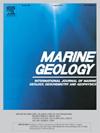河流沉积物地球化学及其在西巽他陆架的扩散模式
IF 2.6
3区 地球科学
Q2 GEOSCIENCES, MULTIDISCIPLINARY
引用次数: 0
摘要
了解大陆架盆地的沉积物产地对于重建古环境变化、提高对沉积动力学的认识以及阐明其对全球碳循环的贡献至关重要。为了破译沉积物产地,加深对巽他陆架沉积物扩散模式和地球化学组成因素的理解,我们对 35 个表层沉积物样品硅酸盐部分的微量元素浓度和锶(87Sr/86Sr)、钕(εNd)同位素比值进行了详尽的分析。这些样本采集自西巽他大陆架及其附近的主要河流末端,即湄公河、拉让河、彭亨河和吉兰丹河。通过应用各种统计方法,包括经典聚类分析、主成分分析(PCA)、La-Sc-Th 辨别图和一系列元素比率,我们确定了巽他陆架上三个不同的地球化学区域。每个区域都有独特的地球化学特征,表明不同的沉积物来源或产地。这种区别主要归因于明显的沉积物异质性,反映了来自不同河流末端的岩性差异。为了全面了解该地区的沉积物来源,还整合了之前对巽他大陆架东部和中国南海南部进行的研究中获得的碲镉同位素数据。通过利用 SrNd 混合模型,并辅以蒙特卡洛模拟,我们估算了周边河流末端沉积物对南海南部海盆的贡献。根据该模型,湄公河是巽他大陆架和南海南部的主要沉积源,这归功于其大量的沉积物输出。此外,该模型还确定了拉让河、彭亨河和吉兰丹河的重要贡献,尤其是在其河口附近的近海地区。此外,该研究还揭示了华南河流(即红河和珠江)对巽他大陆架东部和大陆架以外更深的南中国海区域的影响,而这一影响此前一直未得到重视。这项研究不仅划定了影响巽他陆架和南海的主要沉积物来源,还强调了考虑广泛的河流末端成员以了解活跃海洋环境中沉积动力学的重要性。本文章由计算机程序翻译,如有差异,请以英文原文为准。
Riverine sediment geochemistry and its dispersal pattern on the western Sunda Shelf
Understanding sediment provenance in continental shelf basins is essential for reconstructing paleoenvironmental changes, enhancing insights into sedimentary dynamics, and elucidating their contributions to the global carbon cycle. To decipher sediment provenances and enhance comprehension of the sediment dispersal patterns and the factors governing geochemical compositions on the Sunda Shelf, we conducted an exhaustive analysis of trace elemental concentrations and the isotopic ratios of strontium (87Sr/86Sr) and neodymium (εNd) in the silicate fractions of 35 surface sediment samples. These samples were collected from the western Sunda Shelf and its proximate major river end-members, namely, the Mekong, Rajang, Pahang, and Kelantan Rivers. Through the application of various statistical methodologies, including classical cluster analysis, Principal Component Analysis (PCA), the La-Sc-Th discrimination diagram, and an array of elemental ratios, we identified three distinct geochemical provinces on the Sunda Shelf. Each province is defined by unique geochemical signatures indicative of varied sediment sources or provenances. This distinction was primarily attributed to pronounced sediment heterogeneity, reflecting lithologic variances from the diverse river end-members. In pursuit of a holistic understanding of sediment provenance in the region, Sr![]() Nd isotopic data was also integrated from prior studies encompassing the eastern Sunda Shelf and the southern South China Sea. By utilizing the Sr
Nd isotopic data was also integrated from prior studies encompassing the eastern Sunda Shelf and the southern South China Sea. By utilizing the Sr![]() Nd mixing model, complemented with Monte-Carlo simulations, we estimated the sediment contributions from surrounding river end-members to the southern South China Sea basin. According to the model, the Mekong River emerges as the principal sedimentary source of the Sunda continental shelf and the southern South China Sea, attributed to its substantial sediment outputs. Additionally, the model has identified significant contributions from the Rajang, Pahang, and Kelantan rivers, particularly in offshore regions near their estuaries. Further, this study revealed the previously underappreciated influence of South China's rivers, namely the Red and Pearl Rivers, on the eastern Sunda Shelf and deeper southern South China Sea region beyond the continental shelf. This study not only delineates the dominant sediment sources influencing the Sunda Shelf and the South China Sea but also underscores the importance of considering a broad spectrum of river end-members to understand sedimentary dynamics in an active marine environment.
Nd mixing model, complemented with Monte-Carlo simulations, we estimated the sediment contributions from surrounding river end-members to the southern South China Sea basin. According to the model, the Mekong River emerges as the principal sedimentary source of the Sunda continental shelf and the southern South China Sea, attributed to its substantial sediment outputs. Additionally, the model has identified significant contributions from the Rajang, Pahang, and Kelantan rivers, particularly in offshore regions near their estuaries. Further, this study revealed the previously underappreciated influence of South China's rivers, namely the Red and Pearl Rivers, on the eastern Sunda Shelf and deeper southern South China Sea region beyond the continental shelf. This study not only delineates the dominant sediment sources influencing the Sunda Shelf and the South China Sea but also underscores the importance of considering a broad spectrum of river end-members to understand sedimentary dynamics in an active marine environment.
求助全文
通过发布文献求助,成功后即可免费获取论文全文。
去求助
来源期刊

Marine Geology
地学-地球科学综合
CiteScore
6.10
自引率
6.90%
发文量
175
审稿时长
21.9 weeks
期刊介绍:
Marine Geology is the premier international journal on marine geological processes in the broadest sense. We seek papers that are comprehensive, interdisciplinary and synthetic that will be lasting contributions to the field. Although most papers are based on regional studies, they must demonstrate new findings of international significance. We accept papers on subjects as diverse as seafloor hydrothermal systems, beach dynamics, early diagenesis, microbiological studies in sediments, palaeoclimate studies and geophysical studies of the seabed. We encourage papers that address emerging new fields, for example the influence of anthropogenic processes on coastal/marine geology and coastal/marine geoarchaeology. We insist that the papers are concerned with the marine realm and that they deal with geology: with rocks, sediments, and physical and chemical processes affecting them. Papers should address scientific hypotheses: highly descriptive data compilations or papers that deal only with marine management and risk assessment should be submitted to other journals. Papers on laboratory or modelling studies must demonstrate direct relevance to marine processes or deposits. The primary criteria for acceptance of papers is that the science is of high quality, novel, significant, and of broad international interest.
 求助内容:
求助内容: 应助结果提醒方式:
应助结果提醒方式:


